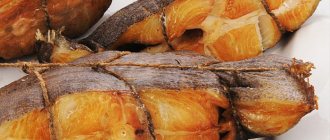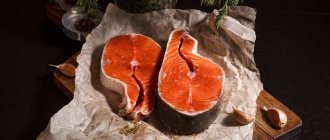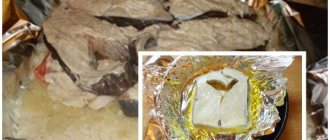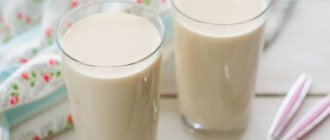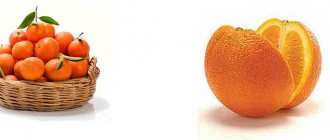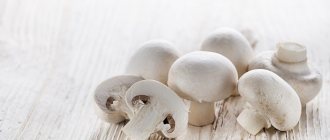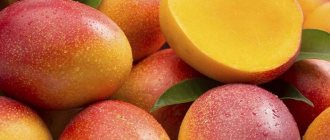Compound
The calorie content of raw pollock per 100 grams is 82 kcal. This amount of fish contains:
- 17.9 grams (36% of the daily value) of complete animal protein containing all the amino acids necessary for humans;
- 52% daily dose of selenium;
- 20% vitamin B6;
- 17% phosphorus;
- 15% vitamin B12;
- 12% potassium;
- 10% niacin;
- 6% magnesium;
- 5% vitamin C.
In slightly smaller quantities the composition includes:
- vitamins – A, E, B1, B2, folates, pantothenic acid;
- microelements - sodium, zinc, copper, manganese, calcium, iron.
The calorie content of boiled pollock is actually the same as that of raw pollock. As for the fried product, it is impossible to accurately indicate its energy value, because it varies greatly from recipe to recipe.
One of the explanations for why pollock is useful for the human body is due to the absence in it of many toxic substances that are present in other varieties of fish.
- Pollock contains very little mercury. Nowadays, the waters of the world's oceans are polluted with mercury. And this heavy metal is deposited in the bodies of many fish. For example, tuna is famous for its health benefits. But in fact, it often turns out to be much more harmful than beneficial, since it contains mercury in its meat. Pollock also contains mercury. But there is much less of it than in the same famous tuna.
- Pollock is always a wild fish. It is never bred on farms. And, therefore, it does not contain antibiotics, pesticides, dyes and other toxic chemicals that are actively used in fish farms.
100.0 g of pollock fillet contains 15.9% protein, 0.9% fat and 0% carbohydrates. The calorie content of pollock is 72 kcal for every 100.0 g of product.
The mineral and vitamin composition of fish is surprising in its diversity. Therefore, the benefits of pollock are beyond doubt. Nutritionists and doctors recommend including it as often as possible in your diet.
The beneficial properties of pollock for human health are also explained by the presence of vitamins (A, PP, B1, B2, B9), iron, sulfur, phosphorus, magnesium, calcium, and polyunsaturated fatty acids.
The benefit of pollock lies in the rich composition of the meat of this fish. It contains vitamins E, ascorbic acid, A, PP, group B, mineral salts - potassium, magnesium, calcium, iron, phosphorus, zinc, cobalt, manganese, as well as fats, including polyunsaturated fatty acids called Omega-3 and Omega-6. Read also: Gotu kola: beneficial properties, contraindications, benefits and harm.
Pollock occupies a leading position among other fish in terms of protein, selenium and iodine content. Fatty acids reduce the level of “bad” cholesterol, stimulate metabolic processes in the body and normalize blood pressure. High-quality protein improves brain and digestive system function.
It is considered not only tasty, but light and healthy food. Confirmation is the chemical composition, as well as the ratio of proteins, fats and carbohydrates. There are practically no carbohydrates in this form; there is a very small amount of fat - 0.9 g per 100 g of product.
Protein, as in any other animal food, is sufficient - 15.9 g per 100 g. 500 g of pollock provides the daily protein requirement of an adult. Considering the price, it is one of the most affordable sources of this element.
It contains vitamin A, E, the entire group B. But most of all - vitamin PP. Of the macroelements, pollock is especially rich in phosphorus (in 100 g 30% of the daily value), potassium and magnesium. Some microelements are simply found in huge quantities. As a percentage (of the daily value) 100 g contains:
- iodine - 100%;
- cobalt - 150%;
- chrome - 110%.
Pollock has a high content of unsaturated fatty acids. Omega-3 fatty acids per 100 g contain more than 20% of the daily requirement.
Attention! Among all products, pollock ranks 73rd in protein content.
Standards for product use
If only pollock is present in your seafood diet, you can eat it 3 times a week, 100 g each. This recommendation from the World Health Organization applies to all seafood. Therefore, the number of different fish dishes in the diet should be combined, calculating the total intake into the body. But in the absence of contraindications, pollock can be consumed daily, the main thing is to minimize the amount of accompanying products (for example, fatty sauces or cooking fish in batter).
Pollock liver has a high nutritional value (about 500 kcal), so it is not recommended to abuse it. The daily allowable dose of this product is 20 g. You should also use pollock caviar with caution, because 50 g of the finished product contains a dosage of salt that is 2 times the daily norm.
Fish fillet in batter
Pollock has pronounced antioxidant properties. With regular consumption of it, the likelihood of developing diseases of the musculoskeletal system and cardiovascular system is reduced, and the risk of malignant tumors is significantly reduced.
The absence of carbohydrates in pollock meat makes this fish indispensable in the diet of people suffering from diabetes.
Many children's doctors advise including pollock in baby food starting from the age of eight months. This is explained by the fact that this fish is rich in iodine and its regular consumption is an excellent prevention of thyroid diseases. Also for the same purpose, pollock is recommended for pregnant women and nursing mothers, as well as all people living in areas of natural iodine deficiency.
It is difficult to overestimate the benefits of pollock for smokers. The vitamin A contained in large quantities in this fish reduces the likelihood of developing lung cancer.
The beneficial properties of pollock include the fact that the meat of this fish helps reduce cholesterol levels in the blood serum and improves brain activity. These properties are explained by the omega-6 and omega-3 fatty (polyunsaturated) acids contained in pollock.
The low calorie content of pollock allows it to be included in the diet of obese people.
In terms of its nutritional properties, pollock is almost in no way inferior to expensive varieties of fish, and at the same time costs several times less. Nutritionists advise eating dishes made from it at least twice a week.
In its nutritional qualities, pollock caviar is not much inferior to black or red caviar. It contains exactly the same amount of vitamins E and C, which are necessary for the functioning of the nervous system, hematopoiesis and good wound healing.
Pollock caviar contains almost two times less phosphorus, which is necessary for building bone tissue, than red caviar. But pollock caviar is lower in calories, so it can be eaten without fear by people who are overweight.
Sodium, which is part of pollock caviar, helps maintain blood pressure at a certain level, promotes the transmission of nerve impulses and muscle contraction.
After drinking alcoholic beverages, pollock caviar allows you to restore vitamin B1 reserves, because 100.0 g of this product contains 1.5 mg of thiamine (vitamin B1).
Regular consumption of this caviar can significantly improve thought processes and memory. This is explained by the action of its constituent nicotinic acid (vitamin PP), which dilates the capillaries of the brain and thereby improves cerebral circulation.
Eating pollock can lead to the development of allergic reactions. Therefore, if you have an individual intolerance to fish or seafood, then pollock should be completely excluded from your diet. It should not be used frequently by those who suffer from kidney disease, arterial hypertension or peptic ulcers of the stomach and duodenum. This is due to the high content of sodium chloride (table salt) in pollock, which can provoke an exacerbation of the disease.
Pollock is useful for weight loss. So what, this fish should definitely be included in the diet menu for all those who want to get rid of excess weight. And that's why.
- This type of fish is a nutritious product containing a minimum of calories. 100 grams of fish pulp provides a person with 36% of the daily protein requirement and at the same time gives him only 82 kcal. Protein is highly satiating and at the same time a thermogenic product. In other words, it speeds up your metabolism.
- Pollock can be freely included in any diet for weight loss, including the most effective low-carbohydrate diets. Patients with diabetes can also eat it without fear.
- Since fish meat contains a lot of vitamins B2 and B12, it provides excellent energy, creating minimal stress on the digestive system. Therefore, it is convenient to include it in the nutrition menu, both before and after training, including training for weight loss.
- Pollock contains omega-3 fatty acids. One explanation for why you need to take omega 3 is that these compounds help you lose weight by fighting metabolic syndrome, increasing insulin sensitivity and the amount of brown fat in the body.
Yes. Both liver and pollock roe are highly nutritious foods. Compared to fish meat, they contain more omega-3 fatty acids and vitamin B12. And, in addition, there is vitamin D, which is difficult to find in foods, and which is so lacking in the cold and dark season.
People quite often compare pollock with other types of fish, mainly cod or hake, wanting to know which is better. And usually, already a priori believing that hake, cod, etc. are better.
In fact, this assumption is incorrect.
The meat of all these fish has the same chemical composition.
As for their culinary characteristics, no one has seriously compared pollock and hake. But a comparison was made with cod.
Not long ago, the US National Marine Fisheries Service conducted a study comparing the taste qualities of pollock and cod. Volunteers were asked to try three different fish dishes and determine which one was made from which type of fish.

More than 60% of study participants were unable to distinguish pollock from cod. Of those who correctly identified fish debris, more than 50% preferred pollock.
So far, no specific harm to pollock has been identified, as well as contraindications for its consumption, with the exception of allergies to fish and individual intolerance to seafood.
In all other cases, the product is safe. Of course, provided that it was frozen fresh and not overfrozen.
Health benefits and harms of pollock: conclusions
Fish of this variety contains many compounds beneficial to human health. But what is even more important is that it does not contain many of the substances that are found in other fish products and which determine their harm.
Thus, pollock is rich in protein, selenium, B vitamins, and omega-3 fatty acids. But at the same time it is free from pesticides, antibiotics, dyes and carries a minimal amount of mercury (no marine fish these days can be completely free from this heavy metal).
This fish is good for the health of the cardiovascular and nervous systems. It helps you lose weight, lift your mood and strengthen your immune system. Allowed for diabetics and all those on a diet.
Pollock is useful for obese people. The calorie content of meat is low - 72 Kcal per 100 g. But this is not the most important thing, the main thing is that the protein in its composition is almost 100% absorbed by the body, stimulating the functioning of the stomach and intestinal motility.
On a diet, pollock is recommended to be consumed boiled, stewed or steamed, for example, in the form of cutlets. With any of these processing methods, the energy value of the product does not increase and the dietary properties remain unchanged.
The ideal side dish for fish would be boiled brown rice and vegetables flavored with various seasonings. Doctors recommend eating pollock for people with weakened immune systems after illness or surgery.
Like any food, the meat of this fish can cause allergies and individual intolerance, which is rare. And the main harm of pollock is the large amount of salt, so it should be eaten with caution by hypertensive patients.

In general, everything is good in moderation. Experts recommend including fish in your diet 2 times a week and then it will not have a negative effect on the body.
To cook pollock in the oven, you will need a large baking sheet. It can be covered with foil.
Products:
- pollock 1600 g;
- 200 g cheese;
- sour cream 200 g;
- 2 onions;
- 3 cloves garlic;
- 5 tomatoes;
- dill 1 bunch;
- salt 10 g;
- seasoning for fish 5 g.
Step by step description:
- Clean the fish, wash it, and cut into portions.
- Cut the onion into half rings.
- Prepare sour cream dressing by adding chopped garlic, dill and salt to the sour cream.
- Place the onion in the bottom of the baking dish and the fish on top. Brush the pollock pieces with sour cream, garlic and herbs.
- Place tomato slices on top of the fish, sprinkle with grated cheese, and brush with sour cream.
- Place in a preheated oven and bake for about 45 minutes at 200°C.
Delicious pollock baked with cheese is ready!

Fish prepared according to this recipe is similar to a restaurant delicacy. It has a slightly lemony flavor and a delicate consistency.
Products:
- pollock fillet 1000 g;
- 100 g lemon juice;
- pomegranate sauce 4 tbsp. l.
For the batter:
- eggs 2 pcs.;
- 10 g salt;
- paprika 6 g;
- 2 tbsp. l. sour cream;
- flour 60 g.
Clean the fish, wash it, cut into portions.
- Rub with salt, add lemon juice and pomegranate sauce.
- Place in the refrigerator to marinate for 2 hours.
- Prepare a batter from eggs, sour cream and flour, do not forget to add salt and sweet ground paprika.
- Place pieces of fish into the oil heated in a frying pan, dipping them into the batter. Fry on both sides until golden brown.
Even those who are not fans of pollock will enjoy this dish.
This recipe makes a wonderful fish casserole.
Products:
- pollock fillet 500 g;
- potatoes 4 pcs.;
- salt;
- pepper;
- nutmeg;
- butter 100 g;
- flour 2 tbsp. l. (with top);
- milk 50 ml;
- cream 50 ml;
- garlic 2 cloves;
- parsley 2 branches;
- cheese 100 g.
Step by step description:
- Peel, wash, cut or chop the potatoes into thin slices. Add salt, pepper and stir.
- Grease the mold with oil. Place the potatoes in an even layer.
- Cut the pollock fillet into pieces, add salt and pepper, and mix.
- Place the fish pieces on the potatoes.
- Prepare a sauce from butter and flour. Melt the butter in a frying pan, add flour, stir for 2 minutes.
- Pour milk into the sauce in a thin stream, stir, pepper, salt, and add ground nutmeg to taste.
- Add cream to the sauce and stir.
- Squeeze the garlic onto the fish and pour the creamy sauce over it.
- Place the mold in the oven at a temperature of up to 190 °C.
- Bake for half an hour.
- Remove the fish, sprinkle it with grated cheese and chopped parsley. Bake for another 10 minutes.
After removing from the oven, divide the fish casserole into portions and garnish with herbs.
- Pollock contains practically no contraindications, except for the presence of an allergy to the product.
- It is also worth considering that eating low-quality and stale fish can cause food poisoning. It is recommended to purchase the product only from trusted places.
Harm
Pollock (the benefits and harms directly depend on the amount of fish consumed) may be contraindicated for consumption if you are allergic to seafood. But it extremely rarely causes an allergic reaction, so it is included in the diet of children older than 8 months. Fish should not be consumed by people who have an individual intolerance to the substances that make up pollock.
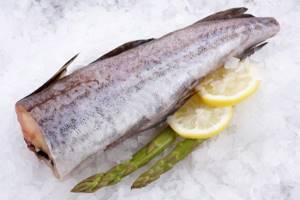
It is recommended to eat it with caution if you have hypertension, since the sea salt it contains helps lower blood pressure. Also, the salt contained can cause damage to the mucous membranes if pollock is eaten frequently. For kidney diseases and disorders of the digestive tract, pollock is recommended to be consumed only boiled or stewed.
Useful properties of pollock
The beneficial properties are determined by the low calorie content, the complete absence of carbohydrates and the presence of unsaturated fatty acids. This fish also contains several essential micro- and macroelements. In terms of the content of some vitamins, pollock also ranks high.
It is especially useful during puberty in teenage girls and menopause in women. Pollock is valued as a source of unsaturated fatty acids, especially Omega-3 polyunsaturated fatty acids. Its use slows down the aging process and improves metabolism.
Eating this fish is good for the female nervous system; it contains a sufficient amount of B vitamins. A huge amount of iodine also has a beneficial effect on the nervous system, and also on the endocrine system. With its help, women's hormonal levels are normalized.
Pollock is recommended for nursing mothers and pregnant women. It will actually replace fish oil without the risk of overdose. Its consumption will reduce the risk of developing cardiovascular diseases, as well as cholesterol levels.
It contains a whole complex of vitamins and minerals that complement each other and participate in metabolism. It is known that peoples who consume fish in large quantities have a well-functioning reproductive system. Also, among them there are no patients with atherosclerosis and cardiovascular diseases.
Important! Scientists have proven a direct link between Omega-3 deficiency and women's tendency to postpartum depression.
As an easily digestible protein food, this type of fish is useful for heavy physical work, intense training in the gym, and muscle exhaustion. At the same time, it contains no carbohydrates and very little fat, which does not create the problem of excess weight. Its positive effect on potency is known.
B vitamins and cobalt strengthen the nervous system. The latter is also very important for the development of the circulatory system. The high content of cobalt, chromium and iodine makes it possible to strengthen your immunity. Iodine is important for preventing problems with the endocrine system, especially the thyroid gland.
- The benefits of pollock for the heart and blood vessels are associated with the presence of large quantities of vitamins B6 and B12. It has been found that if the levels of these vitamins are high, the level of the amino acid homocysteine is low. And the higher the concentration of homocysteine, the greater the likelihood of cardiovascular disease.
- Fish of this variety is included in the list of foods rich in potassium. This microelement is critical for the prevention of hypertension. Often it is a lack of potassium, and not an excess of sodium, that leads to a chronic rise in blood pressure.
- Pollock contains a lot of selenium. In fact, in terms of the amount of this microelement, this fish is second only to Brazil nuts. Selenium ensures the functioning of internal antioxidants of the human body, which play a huge role in the prevention of heart and vascular diseases.
- The presence of omega 3 fatty acids of animal origin, which are necessary to prevent cardiovascular diseases. This fish is not the fattest. And in this sense, the benefits of ordinary herring will be greater, since it contains more healing omega 3 fats. However, pollock also contains them.
- Fish is rich in phosphorus, an element that is critical for the correct passage of neural processes.
- Vitamin B6, which this product is rich in, takes an active part in memory and many cognitive processes. Its decrease is observed in pathologies such as Alzheimer's disease.
- Omega-3 fatty acids are one of the most beneficial classes of bioactive compounds for the nervous system. It is these compounds that prevent premature aging of the brain, treat depression, normalize sleep, and improve mood.
Most serious illnesses, be it cancer, vascular damage, brain damage, etc., are associated with the effects of free radicals on the body. The benefit of pollock is that it is rich in selenium.
By itself, this microelement is not an antioxidant. But without it, the work of the internal antioxidants of the human body is not possible, which often act more effectively than their exogenous (brought from outside) counterparts.
Like any other easily digestible protein food product, pollock is useful in that it provides a person with complete nutrition and thus prevents anemia. However, this fish also has an even more important property for treating anemia. It contains a lot of vitamins B6 and B12, which take part in the synthesis of hemoglobin and the maturation of red blood cells.
Free radicals not only damage cellular structures, they lead to the development of inflammatory reactions in the body. Since pollock has antioxidant activity, it reduces chronic inflammation. And it helps reduce pain in some diseases, such as arthritis.
Additionally, foods rich in omega 3 and vitamin B6 have been shown to be beneficial in relieving chronic headaches and PMS symptoms.
Iodine increases the function of the thyroid gland and prevents diseases of this organ. Selenium neutralizes the activity of harmful substances entering the body.
Pollock caviar is often eaten, the benefit of which is its beneficial effect on the functioning of nerve cells and the entire central nervous system, and due to its ability to improve the absorption of iron, caviar can be used as a preventive measure for anemia.
In addition, it removes excess fluid from the body and strengthens bones, skeleton, cartilage tissue and teeth, so it must be present in the diet of older people.
But caviar does not contain iodine and chromium - microelements that fish liver is rich in. This valuable product improves vision and has a beneficial effect on the condition of hair, epidermis and nails. The liver is often present as part of complex therapy for diseases of the circulatory system, heart and blood vessels.
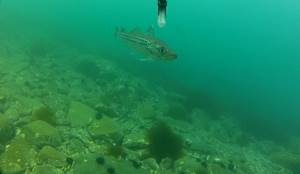
It acts as an excellent regulator of metabolism and is also involved in the metabolism of carbohydrates and fats. Successfully treats eczema and psoriasis and helps cope with genitourinary, viral and fungal infections.
- The product is rich in vitamin A. This substance is very beneficial for the health of bones, teeth, and also prevents vision loss. Carotene is necessary for the growth and normal development of a growing organism.
- Pollock is rich in elements such as calcium and phosphorus, which are also known to play an important role in the formation of bone tissue and the health of tooth enamel. In addition, phosphorus is needed to maintain good condition of nails and hair.
- High iodine content has a good effect on the functioning of the endocrine system and prevents the development of thyroid diseases. In addition, iodine deficiency can provoke mental disorders, cause increased fatigue, insomnia, weakness and loss of strength. Please note that iodine is especially necessary for pregnant women - a deficiency of the microelement can negatively affect the health of the child.
- Regular consumption of pollock helps cleanse the body of the effects of environmental pollution - it is not without reason that people living in polluted areas or megacities are advised to eat the fish.
- Selenium contained in the product has a beneficial effect on the health of the female reproductive system, and also has a very good effect on the condition of nails, skin and hair. It is no coincidence that women experiencing problems with hair (for example, brittleness, hair loss, dullness) are recommended to introduce fish products into their diet.
- Due to the high content of B vitamins, consumption of the product significantly improves the functioning of the nervous system; in addition, the activity of the gastrointestinal tract is normalized. Vitamin B deficiency can cause serious neurological disorders, as well as provoke lethargy and weakness, low mood and sleep problems.
- Fatty acids (omega-3) present in the composition take part in important metabolic processes occurring in the body. They are also necessary for the functioning of the female reproductive system. In addition, fats are a source of strength and energy.
- An undoubted advantage will be the large amount of proteins and amino acids contained in fish. It is especially useful to eat the product for those who are or have finished following a strict diet, as well as for people trying to build muscle mass or experiencing a protein deficiency in their diet.
- Eating pollock also has a beneficial effect on the health of the cardiovascular system, since the fish contains a lot of potassium, which is necessary for the normal functioning of the heart.
- The functioning of the digestive system improves; the intestines are cleansed of waste and toxins, stools are normalized.
- Regular consumption of fish rich in antioxidants reduces the risk of cancer and strengthens the immune system.
How many calories are in pollock?
Pollock is one of the most popular fish species. And not only because of the price. It is healthy, low in calories, and you can use it to prepare even very complex dishes. Its calorie content changes during heat treatment. Much depends not only on the method of preparation, but also on the various sauces and additives. Mayonnaise, sour cream, and cream not only soften the taste, but also add calories.
If you check the calorie content in its “pure” form, the results will be as follows:
- fried - 127 kcal;
- boiled - 79 kcal;
- boiled fillet - 72 kcal;
- stewed - 75.5 kcal;
- baked - 77 kcal.
Calorie content may vary. If you fry it not in flour, but in batter, then the calorie content will increase to 145 kcal. Stewed pollock has no calories, and if it is stewed with vegetables, its nutritional value will drop to 50 kcal. But if you add cheese, then, depending on its type and quantity, the nutritional value can increase to 100-120 kcal.
Benefits and harms of pollock liver
The liver of all cod fish is very useful. It includes:
- proteins (18 g per 100 g of liver);
- Omega-3 polyunsaturated fatty acids;
- vitamins A, D, C, group B, PP;
- iodine, phosphorus, potassium, chromium, manganese, fluorine.
Pollock liver, unlike the fish itself, contains a lot of fat, 40 g per 100 g of product. But basically these are healthy unsaturated fatty acids that are not produced by the human body and must be supplied with food.
But the benefits of canned pollock liver depend on the quality of the canned food. If it is cooked whole, and only salt and vegetable oil are added, then it can be safely recommended as a source of proteins, vitamins and healthy fats.
Interesting! It is from cod and cod that fish oil is produced.
Pollock for children
All cod, and especially pollock, are low in fat and calories. At the same time, they contain a lot of protein, which is necessary for a growing body. Fish puree is recommended to be given to babies from 8 months of age as an additional food to breastfeeding. In addition to protein, pollock contains a lot of iodine, cobalt and chromium. Even 1 tablespoon of puree will provide the daily need of the child’s body for these microelements.
Pollock or its fillet is best suited for this as a low-allergenic product. Complementary foods should be introduced gradually. First, the child is given ¼ teaspoon of puree, then the amount is gradually increased. It is better to use fillet to make puree. Or, as an option, carefully check for the presence of bones in the fish.
Children under 3 years old are not given fried fish. The healthiest cooking method for a child from 8 months to 3 years is steamed fish without salt. By the way, such a dish will be useful not only for children, but also for parents.
Stewed pollock with vegetables and a small amount of fat can be given to children as young as one year old. You can also prepare fish baked in foil or a sleeve for your child. Of course, without sauces or additives. This dish can be introduced into the diet of a child from one and a half years old.
Warning! Red fish is not suitable for feeding babies; it is a strong allergen. It is better to abstain from it until 3 years.
Pollock is useful for a child for the same reasons as for adults, because the little person’s body grows and needs microelements, vitamins and nutrients.
Many types of fish provoke allergies in infants, so they can be used as food no earlier than 2-3 years, which cannot be said about pollock, whose meat is low-allergenic and can be used as complementary food from 7 months. Children can eat pollock in the form of soup, steamed cutlets, or stewed with vegetables and gravy.
Pollock caviar: benefits and harms
Caviar is one of the most common fish delicacies. Let's figure out how useful it is. It, like the fish itself, contains a lot of protein. True, there is much more of it in caviar, 28.3 g. Which is two times higher than in fillet. In this regard, it does not reach the level of the famous red caviar, but in terms of fat content, on the contrary, it is healthier.
The low fat content allows it to be recommended even during a diet. This is a complete source of vitamins, macro- and microelements, but, unfortunately, it is almost impossible to buy fresh caviar.

Stores mainly sell the canned version. Even high-quality canned food is “rich” in excess salt and preservatives. In addition, a lot of cans of caviar have recently appeared on the shelves, where the percentage of content to the total weight is less than 50%. The rest: water, thickeners, flavorings. Eating such “caviar” is not only not beneficial, but also harmful to the body.

How to choose the right pollock
The freshness of a fish is judged by its gills, so it is advisable to have the pollock with its head on. If the gills have a pink tint, then the fish can be taken without fear. The scales should be slightly shiny, without dark spots.
Fresh-frozen fish retains most of its nutrients when it is frozen at the point of catch and delivered to the store without thawing or re-freezing. In this case, the fewer intermediaries, the better. Therefore, you need to buy fish in large supermarkets.
Harm from eating fish may be due to violation of storage terms or conditions. When buying fish, you need to take into account the following factors: Ice crust. It is impossible to find fresh pollock in the store.
Only frozen fillets are sold. Modern technology for preparing fish for sale involves coating the carcasses with an ice glaze, which normally should not exceed 4% of the pollock’s weight.
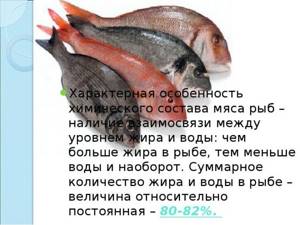
You can determine whether the ice crust meets the norm only by defrosting the fish and weighing it without ice. Color. Fillet of excellent quality is pure white, without spots or streaks of yellowish or pink.
Smell. Pollock is distinguished by a faintly sweetish smell. If stored improperly, fish begins to smell strongly and unpleasantly. Conditions in which the fish was stored. In a supermarket, the refrigerator sensor shows the storage temperature of the fish. It should not be higher than –18° C.
Manufacturer. Producing countries can only be Russia, Japan and China. This is explained by the fact that pollock lives in the north of the Pacific Ocean. For obvious reasons, it is impossible to find a Japanese product on the Russian market; there is fish of Chinese and domestic production.
Russian products should be preferred: they are environmentally friendly. The main sign of a Russian producer is the length of the carcasses is more than 20 centimeters, since it is prohibited to catch young animals. Is there a certificate for the product? Due to their external similarity, tilapia and pangasius are sometimes mistaken for pollock.
Such fish live near the bottom and feed on waste and can accumulate a lot of toxic substances. If the products being sold raise doubts, you can ask the seller for a quality certificate (certificate). Ingredients indicated on the packaging.
The ideal composition, which can be indicated on the packaging, consists of only two elements: fish, water. In some cases you can see E 452 (polyphosphate). This additive ensures moisture retention inside and outside the carcasses. Polyphosphate is banned in Europe, but it is not dangerous.
Comparing the benefits and harms of pollock, we can conclude that the positive properties prevail. Availability, low price, combined with beneficial effects on human health make this fish an indispensable product.
What kind of fish is this
This is one of the most famous commercial fish. To be convinced, just look into the fish departments of any store. Like all representatives of the cod-like order, it is found in the waters of the Pacific Ocean, especially in its northern part.
It is known that the taste and chemical composition of fish are influenced by habitat and nutrition. Growing up, it consumes various planktonic crustaceans. These include larvae, protozoa, crustaceans and molluscs. Growing up, individuals of this species begin to look for larger prey: small fish and squid.
Interesting! The pollock catch in Russia accounts for almost half (42%) of the total annual catch.
Recipe for stewing in sour cream sauce
You can learn how to cook delicious pollock using 11 original recipes. This fish is healthy, it has few bones, so dishes made from it will appeal not only to adults, but also to children.
Pollock with sour cream goes with any side dish and is easy to prepare.

Required ingredients:
- pollock 1200 g;
- 120 g flour;
- onion 1 pc.;
- salt;
- 100 ml vegetable oil;
- sour cream 100 g;
- 250 ml water.
Step by step description:
- Wash and clean the pollock, divide into pieces.
- Bread in flour and fry in a frying pan.
- Finely chop the onion, fry it with two handfuls of flour in oil.
- Add sour cream to the frying pan with the onions.
- Pour 1 tbsp onion. hot water and simmer for 10 minutes.
- Place fried pollock in the prepared sauce.
- Simmer for 7 minutes with the lid closed.
Delicious sour cream sauce is an excellent gravy, and the fish in the sauce turns out very tender and juicy.
Smoked fish recipe
Pollock (the benefits and harms of smoked fish are the least and greatest, respectively, in comparison with other types of preparation) at home can be prepared both by cold and hot smoking.
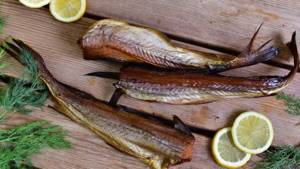
Using the latter option, cooking pollock is relatively quick and easy.
What ingredients will you need?
For hot smoking fish you will need the following products:
- Pollock carcasses – 2-3 pcs.
- Water – 1 l.
- Salt – 100 g.
- Sugar – 20 g.
- Seasoning for fish – 1 tbsp. l.
- Bay leaf – 2 pcs.
Step-by-step cooking process
Before smoking, fish must be salted. When using a hot cooking method, it is recommended to use the wet salting method.
The entire procedure for preparing smoked pollock includes the following steps:
- The fish must be thawed, scaled, gutted, washed and dried slightly.
- Next you need to prepare the brine. To do this, mix water with the rest of the ingredients.
- The resulting mixture must be put on fire and boiled.
- The prepared brine should be cooled well.
- Next, you need to pour the prepared brine over the fish and leave it to salt for 3 hours.
- After the specified time, the pollock carcasses should be removed from the brine and dried a little.
- The next step is preparing the smokehouse. First, its bottom should be sprinkled with shavings or small slivers of alder.
- Next, you should install a special tray where the liquid from the fish will drain during smoking.
- After this, you need to place a grate for food, place the fish on it and seal it with a lid.
- Next, you should build a fire and install a smokehouse.
- The fire must be reduced immediately after smoke begins to come out from under the lid.
- The fish must be smoked over low heat (temperature should be 80-85 0C) for 30 minutes.
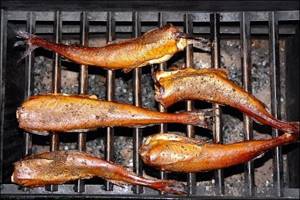
After cooking, it is recommended to leave the fish in the smokehouse for some more time - this way it will be well saturated with smoke and will have a bright taste and rich aroma.
What can I add?
The classic version of the brine can be replaced with a spicy one - this will give the fish new flavor notes. To these ingredients it is enough to add 2-3 peas of allspice and black pepper, ground coriander, cinnamon and other spices suitable for cooking fish.
Serving rules, decoration
Smoked pollock can be served both warm and cold. Fish is mainly served as a separate dish, as it is very high in calories and filling. Due to the content of a large number of minerals and vitamins, pollock has a positive effect on the body. When consuming it, the main thing is to observe moderation so as not to harm your health.
Pollock fried in pieces in a frying pan
This is a universal recipe that can be used to cook sea and river fish.
To prepare you will need:
- pollock 1.5 kg;
- 4 tbsp. l. soy sauce;
- lemon juice 2 tbsp. l.;
- pepper mixture;
- 5 g salt;
- flour 160 g;
- 100 ml vegetable oil.
Step by step description:
- After cleaning the fish, cut it into small pieces.
- Pour soy sauce and the juice of half a lemon, salt and pepper, stir, and refrigerate for 5 hours.
- Heat vegetable oil in a frying pan.
- Bread the fish pieces in flour. Fry until done, about 7-9 minutes. Turn over to the other side and cover with a lid.
- Place the finished pollock on napkins to absorb excess fat.
According to this simple recipe, fried pollock in a frying pan turns out aromatic, golden on the outside and juicy on the inside.
Fried fish recipe
Fried pollock is the easiest and fastest way to cook. To obtain a golden brown crust on the fish and to avoid burning, it is recommended to add a little pork fat or butter to the vegetable oil. And to get rid of the pronounced fishy smell during cooking, you can put potatoes, cut into small pieces, into the vegetable oil where the fish is fried.
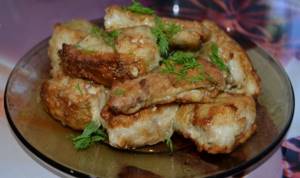
These techniques are suitable for any recipe that calls for frying fish.
What ingredients will you need?
To cook fish you need to take:
- Pollock – 400 g.
- Flour (wheat) – 30-40 g.
- Vegetable oil – 2-3 tbsp. l.
- Salt.
Step-by-step cooking process
The process of frying pollock consists of several stages:
- Pollock fillets should be thawed. It is recommended to remove it from the freezer and leave it in the refrigerator overnight.
- The flour must be sifted.
- Using a sharp knife, remove the scales from the fish and gut it. Particular attention should be paid to the black film on the fillet - if it is not completely removed, the finished dish will have a bitter aftertaste.
- Prepared fish must be cut into small pieces, rinsed and dried with a paper towel.
- The sifted flour should be mixed with salt.
- Pieces of fish need to be rolled in prepared flour so that they are completely covered with flour.
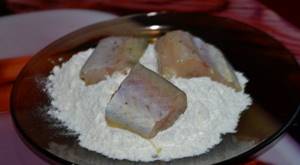
- Vegetable oil must be poured into a frying pan and heated well.
- Place pieces of fish in hot oil and fry on both sides until golden brown.
What can I add?
In addition to salt, you can add ground black pepper or other spices to the flour. They can also be rubbed onto pieces of fish and left for a few minutes to interact, then breaded in flour without spices and sent for frying.
Serving rules, decoration
Fried pollock is recommended to be served warm. You can sprinkle it on top with green onions or other herbs, based on your taste preferences. Fish can be served as an independent dish or with a side dish. The optimal complement to fried pollock would be a vegetable salad or vegetable dishes (cauliflower, zucchini, broccoli, etc.). For lovers of spicy fish, a recipe that involves frying pollock with mustard is suitable.
Preparing such a dish involves the following steps:
- Frozen pollock (400-500 g) should be thawed, cleaned of entrails and scales.
- Next, the fish needs to be cut into small pieces no larger than 3 cm. This will allow the fish to fry quickly and well.
- The next step is to prepare the batter. To do this, you need to lightly beat 2 chicken eggs and then add 2 types of mustard (2 tablespoons each) - French and regular.
- You should also add 3 tbsp to the mustard-egg mixture. l. soy sauce.
- Place flour (150 g) and breadcrumbs (150 g) in separate plates. These ingredients will be needed to fry pollock.
- Next, the prepared fish should be dipped in mustard batter, then rolled in flour, then again in batter, and then in breadcrumbs. This option for preparing fish allows you to preserve the maximum amount of nutrients in it and make it juicy and tender.
- After this, the pollock pieces need to be fried in preheated vegetable oil. For frying, you can use olive, corn or sunflower oil.
- The fish should be fried on both sides until golden brown.
Fried pollock is best served hot. It will be accompanied by a side dish of stewed or fresh vegetables, rice, and boiled potatoes. If the fish is served as an independent dish, it can be decorated with herbs or served with soy sauce.
Delicious fish cutlets
This recipe is remarkable because the pollock cutlets turn out really tasty. The fish fillet is chopped with a knife to preserve the juiciness of the minced meat.
Products:
- pollock fillet 1000 g;
- 200 g white loaf;
- large onion 1 pc.;
- 1 egg;
- salt 20 g;
- 50 g semolina;
- olive oil;
- milk 50 ml;
- dry parsley 5 g;
- ground pepper 2 g.
Step by step description:
- Prepare minced meat from boneless fillet - cut it into small pieces.
- Cut the crusts off the bread, soak it in milk, add semolina to it.
- Finely chop the onion.
- Add the egg, onion and swollen bread to the minced fish.
- Salt and pepper, add dry parsley.
- Knead the minced meat with wet hands until smooth and form into cutlets.
- Heat a frying pan, pour oil into it, and fry the cutlets on both sides over medium heat until golden brown.
- When you turn the cutlets onto the second side, do not forget to cover the frying pan with a lid and reduce the heat.
Delicious fish cutlets are ready!
Calorie content and recipes for popular dishes with pollock
Fried pollock
Ingredients (for 2 servings):
- Pollock carcasses – 200 grams;
- Sunflower oil – 17 grams.
Preparation:
We clean and cut the pollock; Place it on a pre-oiled and heated frying pan and fry the fish on each side until cooked.
Calorie content: 111 kcal per 100 grams.
If fried pollock is cooked with flour, its calorie content will increase to 137 kcal.
Pollock fried in sunflower oil does not contain carbohydrates, which allows this easy-to-prepare dish to be used not only in low-calorie, but also in no-calorie diets.
Pollock in sour cream, baked in the oven (with vegetables and cheese)
Ingredients (for 8 servings):
- Pollock carcasses – 1 kilogram;
- Sour cream and water - 200 milliliters each;
- Onions, cheese, carrots - 100 grams each.
Preparation:
Place the chopped parts of the fish in a greased form; add vegetables; add sour cream and water; sprinkle with cheese; wrap everything in foil and place in an oven preheated to 180 degrees; bake for 20-30 minutes.
Calorie content: 86 kcal per 100 grams
baked dish.
Pollock cutlets
Ingredients (for 6 servings):
- Pollock carcasses – 500 grams;
- Milk – 50 milliliters;
- Sunflower oil – 1-2 teaspoons;
- Onion, loaf - 100 grams each;
- Pepper, salt – 5 grams each;
- Breadcrumbs – 20 grams.
Preparation:
grind chopped pieces of pollock into minced meat; finely chop the onion; soak the loaf in milk and squeeze it out; mix everything, adding spices and salt; form, bread and place the cutlets in a heated and oiled frying pan; fry each piece on both sides.
Calorie content
pollock cutlets:
132 kcal per 100 grams
of finished dish.
Meat, caviar (especially canned) and pollock liver already contain salt. This fish does not need to be salted during cooking.
Steamed pollock
Ingredients (for 6 servings):
- Pollock carcasses – 1 kilogram;
- Pepper, salt (to taste) – 2 grams each;
- Greens (for decorating the prepared dish) – 20 grams.
Preparation:
cut the fish into large pieces; rub with salt and pepper; steam for 20 minutes; remove the pollock from the steamer and let the liquid drain; serve, garnished with greens.
Calorie content: 75 kcal per 100 grams.
Pollock stewed with onions and carrots
Ingredients (for 13 servings):
- Pollock carcasses – 1.5 kilograms;
- Cream and tomato – 50 grams each;
- Sunflower oil – 15 grams;
- Onion – 250 grams;
- Carrots – 100 grams;
- Salt – 1 gram;
- Pepper, spices - to taste.
Preparation:
cut the pollock into small portions and, rubbed with spices, marinate for 20 minutes; finely chop vegetables; mix tomato and cream; first fry the onion, then the carrots and divide the resulting mass into two parts (leave one in the frying pan and the second in a separate plate); place marinated pieces of fish on a vegetable bed and cover with previously fried vegetables; fill everything with a mixture of cream and tomato; simmer for 20-30 minutes.
Calorie content
Stewed pollock with onions and carrots:
per 100 grams – 100 kcal.
Marinated with onions and carrots
This recipe is easy to follow, and the result always exceeds all expectations.
Products:
- pollock 1 kg;
- 3 bows;
- 4 carrots;
- salt and pepper;
- 2 tsp. white wine or apple cider vinegar;
- 450 g tomato sauce;
- 100 ml water;
- oil for frying.
Preparation:
- Clean the fish, wash it, cut into pieces.
- Cut the onion into half rings.
- Grate the carrots.
- Fry the onion until golden brown, add a pinch of ground black pepper.
- Add carrots to the onion, simmer until tender, adding salt and pepper to taste.
- Add tomato sauce to the vegetables in the frying pan and simmer for 2 minutes.
- Add 150 ml of water and vinegar or wine to the tomato dressing in the frying pan, simmer for 3 minutes.
- Salt the fish and place in the prepared tomato sauce in a frying pan. Cover with a lid and simmer over low heat until done.
Pollock marinated with tomato and vegetables goes well with a side dish of boiled potatoes.
What is the difference between pollock liver and cod liver?
Pollock or cod livers differ not only in price. The calorie content of cod liver is higher, 613 kcal, and pollock - 432. The protein in pollock liver is 4.5 times more - 18 g per 100 g of product, in cod - 4.2 g. In terms of carbohydrates, they are equal, but fat in cod liver almost one and a half times more: 65.7 g versus 40 g for pollock.
The indicators for vitamins and microelements are almost the same. This means that the choice between these products is simple: those who need more protein choose pollock liver, those with Omega-3 acids - cod.
In a slow cooker

Amazingly tasty fish on a bed of vegetables, with creamy sour cream sauce, made in a slow cooker.
Products:
- pollock 2 carcasses;
- 2 onions;
- 1 carrot;
- 100 g sour cream;
- 150 ml cream;
- salt;
- seasoning for fish;
- vegetable oil
Preparation:
- Clean the pollock and cut into pieces.
- Salt the fish and sprinkle with seasoning.
- Chop the onion and grate the carrots.
- Pour oil into the multicooker bowl. Add onions and carrots.
- Close the multicooker lid, set the “Bake” or “Multi-cook” mode (125–135 °C) for 40 minutes.
- Prepare sour cream filling, mix sour cream, cream and a pinch of salt.
- Stir the vegetables in the slow cooker. 20 minutes after the start of stewing, place pieces of fish in a multicooker bowl on a vegetable bed.
- Pour the cream and sour cream mixture over the fish in the slow cooker. Close the lid and cook until the end of the program.
Serve with buckwheat porridge or mashed potatoes.
Whole pollock in the oven in foil
Fish prepared according to this recipe turns out tender and tasty. Its preparation takes little time.
Products:
- pollock 1000 g;
- 10 g salt;
- ground black pepper 2 g;
- 3 tbsp. l. lean oil;
- lemon juice 3 tbsp. l.;
- 1 tbsp. l. tomato paste;
- mayonnaise 1 tbsp. l.
Step by step description:
- Clean and wash the fish, rub it with salt and pepper.
- Combine for the sauce: tomato paste, mayonnaise, lemon juice and vegetable oil (olive oil is possible), a pinch of salt. Stir until smooth.
- Cover a baking sheet with foil, grease with oil, place the fish, and pour the sauce on top.
- Cover the top of the baking sheet tightly with foil.
- Bake the fish at 200°C for about 40 minutes.
The finished dish is juicy orange in color.
Boiled dietary fish
Pollock (benefits and harms can be assessed after preparation and consumption) when cooked is considered a dietary dish.
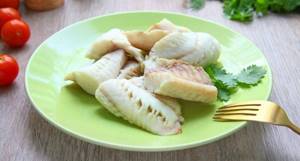
Cooking it in a spicy broth will help diversify the taste of boiled fish.
What ingredients will you need?
To cook pollock you will need the following food set:
- Pollock (fillet) – 2 pcs.
- Drinking water – 0.5 l.
- Carrots – 1 pc.
- Allspice – 2 pcs.
- Black peppercorns – 2 peas.
- Bay leaf – 1 pc.
- Lemon juice – 1 tsp.
- Salt, black pepper (ground) - to taste.
- Vegetable seasoning (added as desired) – 1 tsp.
Step-by-step cooking process
Preparation of dietary fish consists of several stages:
- Pollock fillet (frozen) should be cut into small pieces.
- Sprinkle the cut pieces with lemon juice and leave for a few minutes.
- Pour water into a saucepan, add chopped carrots, all the spices and salt.
- The prepared water should be boiled and simmered over low heat for 7 minutes.
- After the specified time has passed, you need to put the fish fillet into the broth and then boil it for 10 minutes.
- Cooked fish must be carefully removed from the broth.
Serving rules, decoration
Boiled pollock is recommended to be consumed warm. Before serving, you can sprinkle it with ground black pepper or herbs. It is permissible to serve fish with a refreshing sauce based on dill or other herbs. The best side dish for boiled pollock is fresh vegetables - they will make the prepared dish more healthy and diversify its taste.
Reviews about pollock
Olesya Yakovleva, 33 years old, Voronezh
I like pollock because you can make different delicacies with it (meatballs, cutlets, baked) without fear that it will hurt your wallet. I recommend this healthy fish to everyone!
Lida Kraskovskaya, 28 years old, St. Petersburg
I read that pollock has no carbohydrates and is low in fat, and since then I have included it in the menu whenever I want to lose weight quickly (for example, for the holidays). Both tasty and healthy!
Did you find this article useful?

